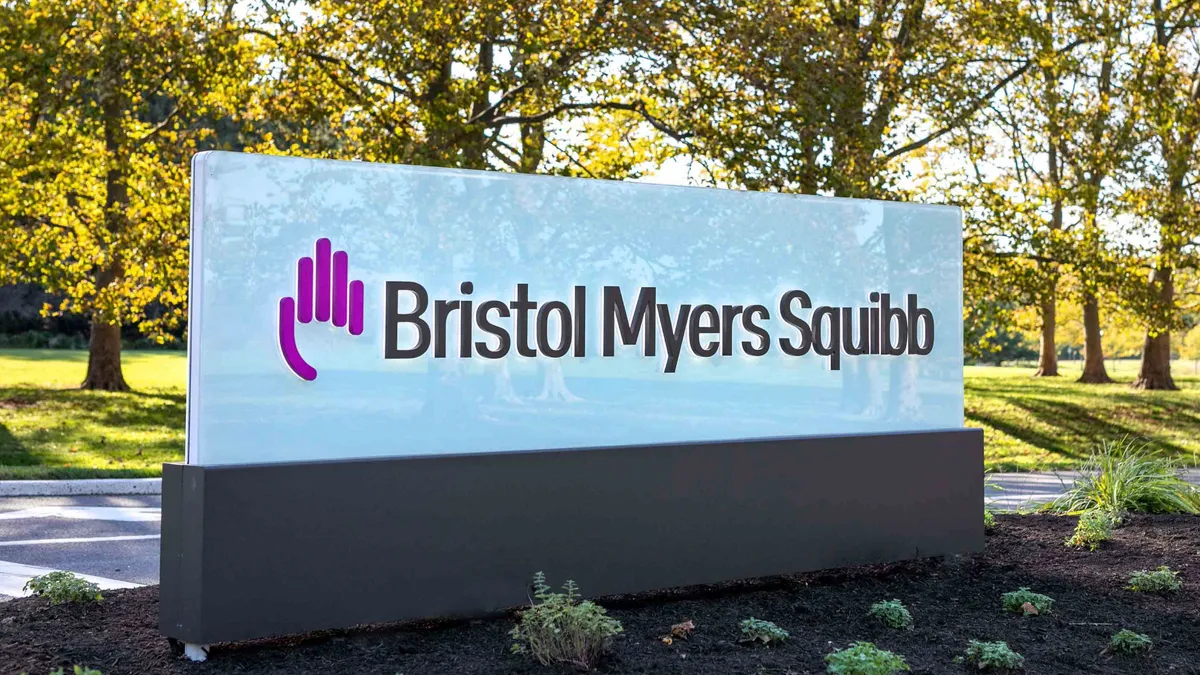Our industry leaders had much to say about patients participating in clinical trials from home, from community sites, virtually — in essence a hybrid of the current system.
What would be the impact of siteless trials on clinical development? A provocative question, and one that we posed recognizing that the practical application of clinical trials devoid of HCP involvement would be near impossible. But the evolution of clinical research toward patient-centric trials and greater patient involvement has led the biopharma industry to consider the use of what are being called decentralized trials. This doesn’t mean in the absence of a trained healthcare provider, but augmented by technology as a hybrid approach to the current site-anchored system. Mobile technologies — such as smart phones, tablets, and wearables — and mobile networks have enabled data collection directly from patients.
Hybrid trials have the potential to impact clinical development in multiple ways, including accelerating patient recruitment time, providing greater access to a 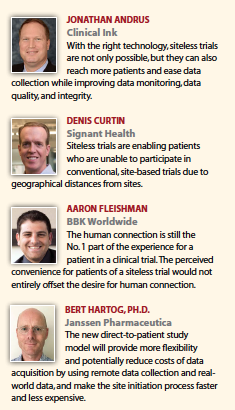 more diverse patient population, and ultimately delivering a more patient-centric experience for trial participants.
more diverse patient population, and ultimately delivering a more patient-centric experience for trial participants.
This shift away from conventional, site-centered trials also holds the promise of significantly reducing clinical trial costs, saving time for recruitment, travel, site staff and operation, site-directed data collection and management, and supply management.
“We refer to this type of trial as a decentralized or direct-to-patient trial," says Bert Hartog, Ph.D., senior director clinical innovation at Janssen Pharmaceutica. “The greatest impact is in diversification of the clinical operational approaches.
Until recently, the conventional, site-centric model was used for all clinical trials across indications and stages of clinical development. The new direct-to-patient and clinical operational models will provide more flexibility and potentially reduce costs of data acquisition by using remote data collection and real-world data, expand patient outreach, make the site initiation process faster and less expensive, decrease study burden, and integrate research into the patient’s life."
He says an additional benefit of direct-to-patient trials is the ability to collect more study data in a real-world setting, which will allow higher frequency data generation and help generate insights without bias resulting from undergoing sporadic assessments in a hospital setting, aka white-coat syndrome.
There is the broader opportunity to decentralize trial operations, which does not suggest the exclusion of trial sites, says Chris Porter, VP, digital strategy, ERT. “Among other elements, our vision of enabling decentralization includes supporting more geographically dispersed sites, bringing trials closer to the patient," he says. “It’s an industry imperative to reduce patient and site burden, thereby eliminating barriers to participation that have historically driven up costs and delayed study timelines. A thoughtful decentralization strategy, which doesn’t necessarily mean wholesale change or the use of untested technologies — can drive efficiencies throughout clinical development and the lifecycle of a clinical trial."
Mr. Porter says decentralization should be considered both at an enterprise level and tailored to the specific protocol. “As such, there is no one-size-fits-all approach to execution. Some protocols may benefit from a few patient reported assessments collected remotely and a reduced site visit schedule, whereas others may call for greater reliance on the patient with elements of the trial conducted at the patient’s home. This might involve eConsent, direct-to-patient drug shipment, in-home healthcare visits, data collection via devices and wearables, plus video-based physician consults. We should think about the best decentralized strategy to most effectively execute a given protocol, considering the patient experience as a major factor."
To be able to deliver on its promises, site-free clinical trials need to pass the first hurdle: regulatory approval for the design, says Mike Jagielski, president and CEO, KCR. “Currently, regulators across the world are analyzing and preparing potential guidelines and policies for the safe execution of site-free clinical trials. Once the FDA and EMA have aligned on their procedural guidelines, we will be able to understand the true potential of site-free clinical trials and gauge their true impact on clinical development."
Adoption of virtual trials has been slow. In a risk-averse, highly regulated environment, change is often difficult, but the evidence is clear: regulators support decentralized, or virtual, trials.
“These virtual models, whether they are siteless or hybrids, have demonstrated impact across therapeutic areas, specialized patient populations and geographies, giving all stakeholders the confidence to embrace them as an innovative way to drive clinical research and healthcare forward," says Josh Rose, VP, R&D, global strategy and head of virtual trials solutions, IQVIA.
Craig Lipset, founder, Clinical Innovation Partners, says thinking about trials going siteless is asking the wrong question; it is about focusing on the technology 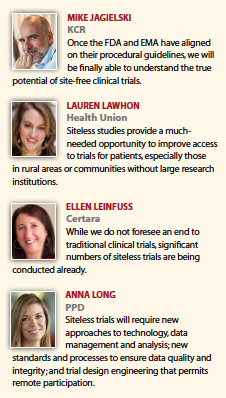 impact rather than what patients want and need. “While siteless seems very simple for patients for an observational study or for testing a digital tool, the idea of taking an investigational new medicine is significant and likely not appropriate to decide by clicking ‘accept’ on an app," he says.
impact rather than what patients want and need. “While siteless seems very simple for patients for an observational study or for testing a digital tool, the idea of taking an investigational new medicine is significant and likely not appropriate to decide by clicking ‘accept’ on an app," he says.
“Siteless should be just an option alongside other options that are meant to understand and meet the needs expressed by the patient. Siteless may work great for some patients at some points in their journey. But for other patients or just at certain times in their journey it may be the patient’s preference to go to a site."
Aaron Fleishman, director, market development, BBK Worldwide, echoes this concern.
“People — and not just patients managing a health condition — want to be seen by a doctor," he says. “They are more comfortable being seen in person by a physician, particularly when they are participating in a clinical trial for the first time and may not be familiar with the ins and outs of participation. I think the human connection is key. We’ve seen this confirmed by research we’ve recently conducted examining the patient-physician relationship and its impact on clinical trial participation. The human connection is still the number one part of the experience for a patient in a clinical trial. I’d be worried that part of the experience might be lost in siteless trials. In my opinion, the perceived convenience for patients of a siteless trial would not entirely offset the desire for human connection."
Impact of Siteless Trials
Whichever term is used, our industry experts say siteless trials have the potential to reduce patient and site burden, provide an incentive for patient recruitment, improve the efficiency of trials, and reduce development costs. Two-thirds of investigator sites fail to meet patient enrollment requirements, according to the Tufts Center for the Study of Drug Development. This is perhaps the most dogged of challenges that the industry has confronted for decades when it comes to clinical development.
Direct-to-patient trials have the potential to address this challenge by tackling the fundamental issue of patient convenience, bringing the site to the patient, coupled with technology led, human centric approaches to patient education. Patient education is further amplified by the growing trend toward patient empowerment, profoundly impacting the effectiveness of patient training and consent, thereby accelerating study start-up times.
Ellen Leinfuss, chief corporate affairs officer at Certera, say while she does not foresee an end to traditional clinical trials, significant numbers of siteless trials are being conducted already, using modeling and simulation. “Mechanistic physiologically based pharmacokinetic modeling and simulation has resulted in the approval of more than 200 labels claims for more than 55 drugs without the need for clinical trials by FDA, the European Medicines Authority, and Japan’s Pharmaceuticals and Medical Devices Agency. PBPK modeling and simulation 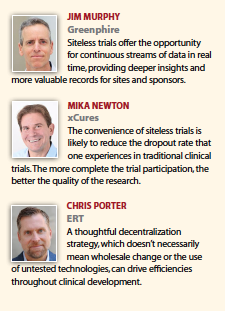 allows many clinical scenarios to be investigated that would be difficult to test in actual trials. They include determining the most appropriate drug dose, and predicting the potential for drug-drug interactions, in vulnerable populations such as pregnant women, pediatric patients and neonates, patients with complex diseases or co-morbidities that require them to take multiple medications, or those with impaired liver or kidney function."
allows many clinical scenarios to be investigated that would be difficult to test in actual trials. They include determining the most appropriate drug dose, and predicting the potential for drug-drug interactions, in vulnerable populations such as pregnant women, pediatric patients and neonates, patients with complex diseases or co-morbidities that require them to take multiple medications, or those with impaired liver or kidney function."
Siteless trials ease site burden, says Jonathan Andrus, chief business officer, Clinical Ink. “By assigning a virtual study coordinator, sites can use both voice and video to connect with patients based on an agreed-upon schedule for collecting the needed data," he says. “If there is a need, depending on the specific data requirements for the study, the coordinator can either meet with patients at their homes or at a convenient location to perform needed study procedures — much like a home health nurse. Using direct data capture tools, coordinators can collect needed audio and video and enter data related to the virtual site visit.
Sponsors benefit, Mr. Rose says, from improved efficiency gained through time and cost savings as well as from cleaner, more frequently delivered data, which allows investigators to rapidly identify trends related to safety and clinical outcomes.
As our industry works to strengthen patient-centricity, we have already seen how siteless — or virtual — trial models are improving the clinical research experience for all stakeholders," Mr. Rose says. “When we can eliminate or reduce the number of site visits, we can reduce costs, more easily recruit and retain patients, and deliver better data than a traditional site-based trial. Virtual trial models change the clinical research paradigm by leveraging telemedicine, IoT, and remote data-capture to reduce or eliminate the need for clinical sites entirely."
Currently, across several therapeutic areas, a number of open clinical trials are increasingly competing for the same pool of available patient participants. This dynamic is contributing to delays in completing clinical development programs and impeding the ability of the industry to bring forward important medicines in a timely manner.
“Shifting more clinical trial activities to the patient’s home will allow sites to focus on remaining activities that can only be performed in the hospital setting (imaging, invasive procedures, etc.), this will save time and reduce the site burden, Dr. Hartog says.
Siteless trials could transform oncology drug development, reducing the capital requirements, increasing the diversity of tumors included in clinical trials, and speeding development of medicines that could give patient more time with their families, says Per Hellsund, VP of marketing, Cybrexa.
“We can’t possibly uncover the diversity of mutations responsible for cancer without a diversity of patients," Mr. Hellsund says. “Cancer therapy is transforming as we learn more about the molecular triggers of cancer. There are several approved cancer drugs that target the identified triggers, but tumors 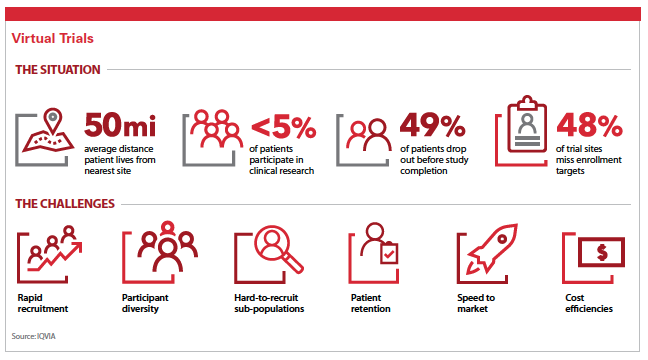 eventually progress by finding ways to escape these therapies. To beat cancer, we need to understand all of these molecular triggers to cut off the escape routes for tumors."
eventually progress by finding ways to escape these therapies. To beat cancer, we need to understand all of these molecular triggers to cut off the escape routes for tumors."
Easing the Burden on Patients
Today, a key issue is the burden that participation in clinical trials can place on patients and their families, since participants often undergo lengthy visits at clinical sites and must travel from home to the clinic multiple times over the course of a trial, which can be difficult for some patients based on medical conditions or existing daily commitments.
“Patient-centric approaches are becoming more desirable," says Jim Murphy, CEO, Greenphire. “We really can’t get more patient-centric than a siteless trial, which provides the convenience of participation in the comfort of his/her own home. The impact of siteless trials on clinical development lies in the richness and completeness of data sets that can be captured with this model. With onsite trials, patients may only be able to provide a single snapshot of data based on a specific interval of what he or she can remember, and often how they feel that particular day."
Siteless trials, Mr. Murphy adds, offer the opportunity for continuous streams of data in real — or near real — time, providing deeper insights and more valuable records for sites and sponsors. “The trends are clearly driving toward the flexibility to apply a remote siteless dynamic, with more opportunity to incorporate remote visits and gain more data with fewer visits."
It would absolutely be game changing if we could bring trials to patients instead of relying on the existing infrastructure of clinical trials, says Jason Coloma, CEO, Maze Therapeutics.
“Not only would we be able to recruit trials faster, we would be able to increase the ethnic diversity of trial participants to properly reflect the population and perhaps see safety issues and efficacy signals sooner," he says. “One would have to believe that overall costs of trials would go down once the initial infrastructure is set up to handle siteless trials. Finally, we would be able to engage an entire set of physicians earlier who actually see a higher percentage of patients rather than just relying on academic investigators. The clinical development and commercial insight could be tremendous."
Siteless trials offer great promise for expanding and enhancing clinical trial participation, ultimately making the trial experience first and foremost about the patient, our industry experts say.
“Distance and convenience barriers that traditionally have impeded participation would be removed, and the impact on and energy devoted by patients would be reduced through endpoint collection from the comfort of their own homes via a device, wearable or home health nurse, or from a local lab or clinic," says Anna Long, VP, enterprise strategy and innovation, PPD. “Because of these changes, trials are likely to appeal to a greater diversity of patients, especially younger generations that have grown up with technology and the flexibility and interactivity it affords."
PPD recently surveyed individuals on their interest in participating in a virtual trial with direct data collection, and more than 70% indicated they would. Notably, this survey took place among a group of patients that was more than 80% research naïve.
“With so few eligible patients participating in clinical trials today, there is significant upside in terms of potential patient access and, as a result, accelerated trial enrollment timelines," Ms. Long says.
The impact on data quantity, quality and the data itself also will drive meaningful change to clinical development. Real-time data reporting has the potential to lead to far greater transparency, enabling sponsors to have clearer insights into their studies and facilitating faster and better decision-making.
“Siteless trials imply a potential evolution of clinical endpoints, both in terms of new digital equivalents to existing standards, and novel digitally derived endpoints that may be possible through new collection mechanisms," Ms. Long says. “These changes will require new approaches to technology, data management and analysis; new standards and processes to ensure data quality and integrity; and trial design engineering that permits remote participation."
When it comes to participating in clinical trials, the idea of “finding a study site near me" is often a key barrier for interested and potentially qualified patients. Results from Health Union’s clinical trial programs indicate that 40% to 60% of potentially qualified patients are excluded due to location restrictions via online screening.
“Siteless studies provide a much-needed opportunity to improve access to trials for patients, especially those in rural areas or communities without large research institutions," says Lauren Lawhon, chief operating officer, Health Union. “Siteless trials can also prove beneficial for patients who live within a reasonable distance of a clinical trial site by reducing the personal burden for patients to participate. For some people, the number of visits and assessments required by a protocol can become overwhelming at times."
Ms. Lawhon says through the use of home health services, visiting nurses, ambient tracking and telemedicine, siteless trials make it easier for people to fit the study requirements into their lives. “As the pharma industry looks to find more ways to become patient-centric, siteless trials come to mind as a great example. By bringing the clinical study to the patient and ‘meeting them where they are’ instead of requiring patients to travel to a site for care, more people may be able to consider clinical trials as a treatment option."
One of the best ways to find and retain patients is to offer a different clinical trial model — one where patients can be involved in the study in a way that allows them to enroll and stay in the study while also balancing a busy schedule, Mr. Andrus says. “With the technologies available today, more organizations could embrace a siteless approach, which I believe would have a significant impact on the industry’s current inability to attract and retain a sufficient number of patients."
As we shift towards less reliance on central clinical sites and more toward distributed clinical development, we will witness a higher participant engagement rate, says Nancy Yu, CEO, RDMD. “Patients do not want to upend their lives to travel across the country every few weeks. If we can minimize the number of visits that require travel, especially in the case of natural history studies, where no interventional drug is being administered, we can begin to ease the pathway for programs to be initiated in new diseases, such as rare disease."
Siteless trials will broaden the patient pool, says Mika Newton, CEO, xCures. “The time and expense of traveling to a site, on top of the overall time commitment to take part in a trial, are significant barriers for patient enrollment. Remove or reduce that barrier and you have a larger patient pool, which is bound to have a positive impact on the research and thus on the clinical development."
Additionally, the convenience of siteless trials is likely to reduce the drop-out rate that one experiences in traditional clinical trials, Mr. Newton says. “The more complete the trial participation, the better the quality of the research. At the same time, not all trials could be completely siteless. For example, for a type 2 diabetes trial, where drugs can be delivered to individual patients and accurate blood glucose testing could be captured remotely through continuous glucose monitors, it could truly be siteless. For an oncology trial, however, it may be necessary for a patient to come to a community cancer center. Still, it could be an improvement — and encourage broader participation — over having to make regular trips to a big-city cancer center."
Siteless trials are enabling patients who are unable to participate in conventional, site-based trials due to geographical distances from sites or physical traveling limitations due to their disease, to be identified and enrolled, says Denis Curtin, principal, eCOA and patient engagement, Signant Health. “We are also now able to engage patients where they are, at home," he says. “Patient access to phone or computer software has improved trial retention. It has also allowed directed protocol activities including dosing, surveys, and clinical data collection to be completed on time, in sequence, and remotely without site visits or other interventions."
Siteless trials enable patients to convey data collected at home via instrument, wearable, or physical sample and allow for the capture of data that is different and often more consistent with their condition than data collected by trial site staff. “We can also continue to shift the operational burden away from sites," Mr. Curtin adds. “Clinics and other institutions that conduct multiple concurrent trials are often challenged to conduct patient visits that are consistent with the demands of ever-more complicated trial protocols and the needs of patients. Siteless trials are viewed as one solution to this problem since patients are managing their own protocol tasks at home."(PV)
~~~~~~~~~~~~~~~~~~~~~~~~~
Defining the Future
Oracle released a 2019 Market Research Report: The Use of Virtual Components in Clinical Trials designed to uncover how key stakeholders define the term “virtual clinical trial" for trials that involve a principal investigator (PI). A variety of terms have been used to describe clinical trials that incorporate at least some patient-facing technology, e.g., a tablet provided to patients for them to record basic data related to the study, a smartphone app to provide patients with guidance on protocol adherence, a wearable sensor that transmits data to the study team, etc. These terms include decentralized trials, remote trials, direct-to-patient trials, hybrid trials, patient-centric trials, and most commonly, virtual clinical trials. None of these terms, however, has an accepted definition across the industry; rather, each of them has a number of disparate definitions attached by various groups or companies in the clinical trial space.
This is particularly the case for the term “virtual trial." There was little agreement among focus group participants when it came to defining the term. In fact, Oracle reports that most acknowledged that this lack of a common definition is a source of confusion within the industry. Participants gave a variety of conditions they felt defined what constitutes a virtual clinical trial. Some felt that the use of almost any patient-facing technology constitutes a virtual trial. Others said that a virtual trial only describes those where every aspect of the trial after protocol design are entirely technology-based, from patient recruitment and consent, to data collection. By this definition, there would be no physical trial sites for patients to visit, and neither the PI nor anyone else involved in the study would ever have face-to-face interaction directly with the patient.
Most participants describe the current state of hybrid trials as involving technology for data gathering, data reporting, or patient/provider interaction, including the use of patient-worn sensors and smartphone apps to maintain patient participation and compliance.
From the site survey that was conducted at the Global Site Solution Summit, the majority of sites that responded to the poll (79%) are involved in decentralized trials.
The three most common “virtual components" used in decentralized trials were mobile technology (92%), web-based patient diaries (84%), and wearable technologies (82%).
~~~~~~~~~~~~~~~~~~~~~~~~~
Technology Makes Siteless Trials Possible
 Robert Goldman, Ph.D.,
Robert Goldman, Ph.D.,
Head, Global Clinical Research & Medical Affairs, Sunovion Pharmaceuticals
Continued refinement of technologies and logistics to enable the possibility of siteless trials will continue to expand over the coming years. The broad introduction of siteless trials would have the potential to increase patient participation, reduce clinical development cycle times, and enhance the industry’s ability to bring medicines to patients in a more expeditious manner. With the conduct of siteless trials, it would be possible to obtain as much data as possible in the patients home environment, which would be an enormous step forward in improving the clinical experience for patients and their families. Advances in digital technologies are already enabling collection of continuous real-world data in the patient’s own environment that complement and extend traditional clinical trial endpoints. Digital technologies will continue to create more opportunities for the industry to provide meaningful information about the difference our treatments make in the daily lives of patients.
 Dave Meyers
Dave Meyers
National Director U.S. Life Sciences, Microsoft
Over the last few decades, technology has made possible dramatic advances in medical science that are improving health outcomes worldwide. But while new medical discoveries continue apace, one area that has not been effectively transformed has been the process of clinical research and clinical trials. Innovations in clinical trials, siteless, virtual, remote clinical trials, hold the promise of shortening the cycle time of trials, expanding the pool and diversity of participants, improving the patient experience and retention in trials, and ultimately bringing new treatments to patients sooner.
Recent advancements in technologies, such as cloud and IoT, are at a point where the industry can really deliver on the promise of clinical research innovation such as siteless trials. In particular, what we call the intelligent cloud and intelligent edge that have cognitive services — AI — built-in, together with a new generation of sensors and wearables, standards-based (FHIR) data exchange, mobile apps and telemedicine can all be targeted at clinical trials to produce enhanced trial designs, more effective recruitment, more efficient trial conduct, and an improved participant experience.
The intelligent cloud and intelligent edge, together with advances in wearables and smart medical devices, alongside telemedicine have the promise to dramatically reduce the impact on patients of participating in clinical research. The underlying technologies exist today that can fundamentally change clinical trials paradigms to increase efficiency and effectiveness.
 Srinivas (Srini) Shankar
Srinivas (Srini) Shankar
VP and Head, Life Sciences Business Unit, Cognizant
Technology advancement and broad-based commercialization of wearables and sensors are pivotal to the shift towards siteless trials enabling remote, unobtrusive and real-time capture of patient data. This use of sensors and real-time data capture vastly improves the quality of clinical data with the potential to reduce site queries and monitoring visits, not to mention the accessibility to unprecedented volumes of patient data to power safety and clinical insights.
At the same time, regulatory requirements and inertia to change are important considerations in designing clinical studies.
In many instances, patients are happy to visit clinical trial sites and prefer transitional physician-patient interaction. The trial design has to be “fit-for-patient," allowing for hybrid models to cater to the diverse physical and emotional needs of patients.
In summary, a siteless trial model offers the combined benefits of patient engagement, cost-savings, accelerated timelines, and data accuracy.
This trend is here to stay, and sponsors will continue to explore the spectrum of options to determine the right mix of operating models and technology interventions based on therapy nuances.
~~~~~~~~~~~~~~~~~~~~~~~~~
Jonathan Andrus
Clinical Ink
With the right technology, siteless trials are not only possible, but they can also reach more patients and ease data collection while improving data monitoring, data quality, and integrity.
Denis Curtin
Signant Health
Siteless trials are enabling patients who are unable to participate in conventional, site-based trials due to geographical distances from sites.
Aaron Fleishman
BBK Worldwide
The human connection is still the No. 1 part of the experience for a patient in a clinical trial. The perceived convenience for patients of a siteless trial would not entirely offset the desire for human connection.
Bert Hartog, Ph.D.
Janssen Pharmaceutica
The new direct-to-patient study model will provide more flexibility and potentially reduce costs of data acquisition by using remote data collection and real-world data, and make the site initiation process faster and less expensive.
Mike Jagielski
KCR
Once the FDA and EMA have aligned on their procedural guidelines, we will be finally able to understand the true potential of site-free clinical trials.
Lauren Lawhon
Health Union
Siteless studies provide a much-needed opportunity to improve access to trials for patients, especially those in rural areas or communities without large research institutions.
Ellen Leinfuss
Certara
While we do not foresee an end to traditional clinical trials, significant numbers of siteless trials are being conducted already.
Anna Long
PPD
Siteless trials will require new approaches to technology, data management and analysis; new standards and processes to ensure data quality and integrity; and trial design engineering that permits remote participation.
Jim Murphy
Greenphire
Siteless trials offer the opportunity for continuous streams of data in real time, providing deeper insights and more valuable records for sites and sponsors.
Mika Newton
xCures
The convenience of siteless trials is likely to reduce the dropout rate that one experiences in traditional clinical trials. The more complete the trial participation, the better the quality of the research.
Chris Porter
ERT
A thoughtful decentralization strategy, which doesn’t necessarily mean wholesale change or the use of untested technologies, can drive efficiencies throughout clinical development.



